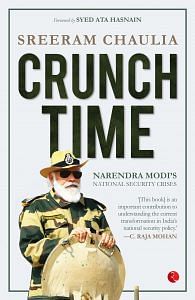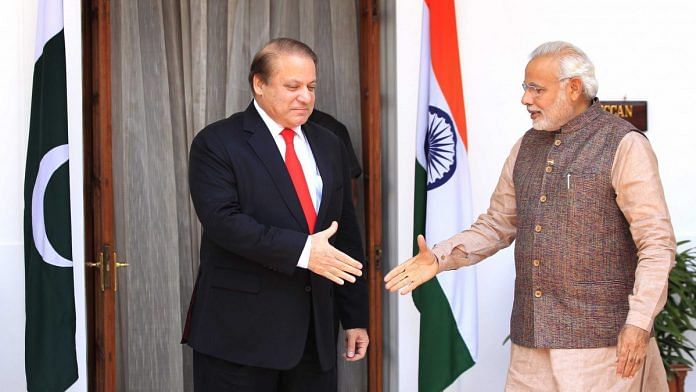On 25 December 2015, Prime Minister Narendra Modi was in Kabul, Afghanistan, to dedicate the new Afghan parliament building, a gift from India to a fraternal country. Sticking to the geopolitically effusive script of deep and affectionate India–Afghanistan friendship and the insecurities it was generating in an envious and meddlesome neighbour, he took aim at Pakistan, saying, ‘There are some who did not want us to be here’, and ‘others who were uneasy at the strength of our partnership’. Unfortunately, any and all assistance by India to stabilise the moderate Afghan government for two decades since the US invasion of Afghanistan in 2001 had been in vain. In August 2021, the US abandoned the weak regime of President Ashraf Ghani, which fell to a swift Pakistan-backed Afghan Taliban military offensive. Islamabad celebrated the return of its jihadist allies to power and New Delhi had little option but to prepare for the possibility of increased national security threats from emboldened terrorists, whose morale was sky- high, in both Afghanistan and Pakistan. More India–Pakistan friction and crises loomed on the horizon.
But rewinding to late 2015, there was still some optimism. After inaugurating the new Afghan parliament structure in Kabul, Modi, on the way back in the evening, suddenly and unexpectedly landed in Lahore—Pakistan’s metropolis and the political bastion of Prime Minister Nawaz Sharif. The Indian leader had invited himself to Sharif’s granddaughter’s wedding over a phone call and was personally received by his counterpart at the airport. As images and videos went viral across the world, the news media swooned with superlatives at the rarest of rare spectacles, the Indian and Pakistani prime ministers walking in tandem on the red carpet, hands clasped and displaying a personal bonhomie, suggesting back-channel contacts much before the drama in Lahore unfolded in public glare.
No official talks or business was conducted during this optically dazzling stopover which lasted around two hours. But the symbolism of an Indian leader setting foot in Pakistan for the first time in 11 years, bonding effortlessly with counterpart Sharif and ringing in a positive tone ahead of scheduled lower-level bilateral diplomatic talks was unmissable. Modi had launched himself on the world stage by inviting the heads of all the South Asian countries, including Sharif, to his swearing-in ceremony in May 2014. He vigorously pursued a ‘neighbourhood first’ foreign policy from his first day in office. The personalized attention he gave to countries small and large across the subcontinent and his pragmatic intervention in resolving outstanding bilateral disputes and winning hearts on the world stage made amends for Manmohan Singh’s lacklustre and aloof performance in India’s immediate backyard. Modi’s grand vision was (and still is) to integrate South Asia into a cooperative common space where trade, commerce and people flow smoothly across borders, and regional governance problems are resolved through trust and collective mechanisms.
Also read: Day before Imran’s no-trust vote, Pakistan army chief condemns Ukraine war, cosies up to West
Knowing individual leaders and having their confidence held the key to the fulfilment of this ambitious dream. The Indian prime minister has often elaborated the philosophy behind his personalized diplomacy. Relations between countries, he remarked, ‘depend less on “full stops and commas on papers” and more on relations between leaders. How much they know each other, how is their chemistry, these are very important’. A believer in personal chemistry with peers, Modi genuinely sought out Sharif as someone who could be befriended and made a partner in his mission of removing obstacles to transborder economic and cultural integration and reviving the moribund South Asian Association for Regional Cooperation (SAARC). Sharif, a former businessman, without an apparent and innate hatred for India, played along in the expectation that if connectivity with India and the rest of South Asia improved, it would offer Pakistan a way out of its perpetual
economic woes.
What Sharif did not reckon with was yet another fierce pushback from the deep state in Pakistan against the attempted normalization of relations with its mortal enemy. He had been ousted once before in a military coup in 1999 for being a ‘traitor’ who came under Indian pressure to withdraw Pakistani troops during the Kargil War. His camaraderie with Modi pleased moderate Pakistanis but riled the military establishment. In an uncanny déjà vu, an extended India–Pakistan crisis would commence within days of his hobnobbing with Modi and Sharif would end up suffering a ‘soft coup’ shortly thereafter. The Introduction of this book explains that Pakistan is a textbook case of a ‘national security state’ that has never seen dual power centres even during spells of directly elected ‘democratic’ rule. The history of Pakistan can be summarised as a Kabuki theatre where the establishment military-intelligence complex calls the shots and reins in civilian politicians who dare to marginalise them and cooperate with India.
Modi certainly knew this sordid past quite intimately. His mentor in the BJP and former prime minister, Atal Bihari Vajpayee, had ridden in a celebrated bus journey from Amritsar in India to Lahore in February 1999 and was welcomed with open arms by Prime Minister Sharif. It was an elaborate diplomatic summit, compared to the brief Modi–Sharif tête-à-tête of 2015, with official talks between the two sides, and a declaration that had the status of an international treaty to control vertical nuclear proliferation and avoid accidental
use of nukes. Vajpayee had hailed it as ‘a defining moment in South Asian history,’ but that effusive feeling vanished in just a few months when the Pakistani military encroached into Kargil without Sharif’s knowledge and India had to wage a prolonged two-and-half-month quasi-war to dislodge the intruders, sacrificing over 500 of its troops in the process. In 2018, when Sharif had again been hounded and sidelined by the military, he looked back remorsefully at that seminal episode in South Asia and expressed how helpless he felt:
“Vajpayee told me he had been stabbed in the back with the Kargil misadventure because it came soon after the Lahore Declaration. I told him I would have said the same thing if I were in his place.”
Also read: Pak Army chief Bajwa says all disputes with India should be settled peacefully through dialogue
By 2020, Sharif was in self-imposed exile. He minced no words and identified the main barrier to peace with India as the deep state in Pakistan, whose corruption and primacy in
Pakistan are facilitated by sustaining an ambience of permanent hostility toward India. As an upcoming leader in the BJP and a professed disciple of Vajpayee, Modi was aware of the dynamic of civil-military imbalance in Pakistan and the risk of blowback from the military establishment against India whenever there is momentum for bilateral cooperation. Still, after coming to power at the national level in India, he wanted to give peace a shot as part of his region-wide ‘neighbourhood first’ policy and conviction that he was destined to play a leadership role in the subcontinent.
Was Modi being naïve and blind to the fundamental reality of Pakistan? So alleged his critics and political opponents after the thaw unravelled and a major national security crisis arose with the Pakistani jihadi attack on an IAF base at Pathankot, in the northern state of Punjab, on New Year’s Day of 2016, hardly one week after Modi had been in Lahore.10 Subsequent investigations of the Pathankot attack, which had scalped the lives of seven Indian security forces and a civilian, found that it had been planned by the ISI and JeM commanders long prior to Modi’s Lahore trip. The six jihadists who sneaked past the international border unchecked and breached the perimeter fence of the airbase had trained for six months in Bahawalpur, the JeM’s headquarters in Pakistan, before proceeding on their holy martyrdom mission. The Pakistani military may have decided the exact timing of the attack to derail the nascent Modi–Sharif peace process, but it would have been attempted nevertheless, even if Modi never went to Lahore.
The American scholar Christine Fair found from her primary research in Pakistan that JeM was being revived by the ISI as part of the internecine, jihadist factional balancing games inside Pakistan. JeM terrorists, she wrote, had ‘long been poised for infiltration into India’ and ‘the only thing surprising about this Jaish assault [on Pathankot] is that it did not happen sooner’.13 As explained in the Introduction, even 26/11 was a diabolical by-product of the intra-jihadist churning inside Pakistan as well as the machinations of its military establishment to remain on top of its troublesome progeny. Pathankot was not caused by Modi’s unclenched hand of friendship with Sharif but by the systemic design of Pakistan’s
national security state.
 This excerpt from ‘Crunch Time’ by Sreeram Chaulia has been published with permission from Rupa Publications.
This excerpt from ‘Crunch Time’ by Sreeram Chaulia has been published with permission from Rupa Publications.






